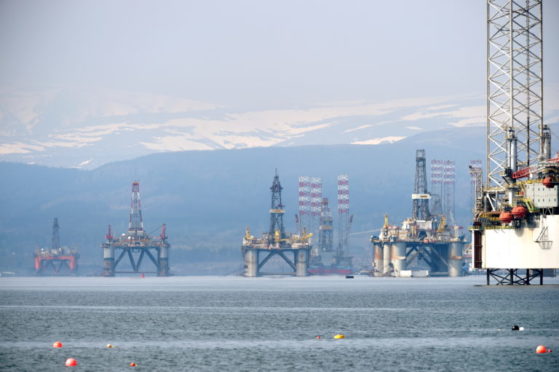There has long been an easy way to monitor the health of the offshore oil industry. If the Cromarty Firth is hosting no drilling rigs, or only a few, then it’s in good shape.
If, however, there are many of these structures in Ross-shire’s renowned waterway, things aren’t so good. Two days ago, there were 15, but in April the figure was 17. We know why.
There was the collapse in oil prices in the spring (they went negative in the US for the first time in history) after the Saudi/Russia clash over production.
Then there was the sharp fall in demand as the pandemic drastically curtailed travel. It meant there was little point in the rigs searching for oil beneath the waves.
Bad news for the sector, already under pressure from the increasing demands for climate change mitigation constraints. But it is also bad news for some who live around the firth.
The P&J reported a week ago on the growing number of complaints about the number and distribution of rigs in the firth.
Between May 29 and July 1, there were 19 formal complaints lodged with Highland Council, compared to just five in the 10 months prior, according to freedom of information statistics.
Each related to noise, light and vibration coming from the rigs. The Cromarty Firth Port Authority (or the Port of Cromarty Firth as it is now called) said: “While rigs are with us, we work closely with the rig managers to minimise any disturbance to local communities.”
The arrival of the Transocean Leader, a semi-submersible drilling rig, a few days ago deepened concerns.
At the weekend it was moored an estimated 600 to 700m off the harbour at Cromarty, within a Special Area of Conservation for the protection of dolphins, and in direct line of sight of the local hotel.
There had already been a passionate series of social media exchanges between residents of the former royal burgh, complaining how much the rigs detract from local life.
This columnist can claim some insight as 13 can be seen from my place of writing. Some are very close. They have come and gone in over three decades of local residency, without really offending or disturbing me. I wasn’t alone.
In the past many local residents were employed building rigs and platforms across the mouth of the firth at Nigg fabrication yard, or round at the Ardersier yard.
The rigs that came back to the Cromarty Firth for upgrading work provided further employment. Those that were resting like an out of work actor – like so many today – less so.
As a consequence, feelings have been running higher than before over their number and proximity. Some would like to see them gone altogether. Most reasonably argue that there should at least be local consultation and strict limits on how close to the shore they can be moored.
This is directed at the Invergordon-based port authority. It was created by an act of parliament in 1973, to be responsible for the management of the firth.
It is a statutory body that conducts commercial activities. But all profits have to be reinvested, “in the port’s development for the benefit of current and future generations” according to its own website.
One of its commercial activities is the mooring of rigs, from which it earns up to £3,400 a week for each one.
But many of the current generation of Cromarty residents don’t believe they are compensated in any meaningful way for the impact the rigs have on their lives. They can point to the many wind farms across the Highlands, which now accept they should pay tens of thousands of pounds in community benefits.
The proposed nine-turbine development north west of Lairg on the Sallachy Estate, for example, is offering £200,000 annually split between the nearest local communities.
The principle is that there should be at least a little sharing of the wealth being generated from a natural asset, like wind. That should also apply to a natural waterway like the Cromarty Firth, created not by private capital investment, but millennia of geological history.
The port authority gives to local causes, as its newsletter records: “In 2019 the port awarded £36,000 to projects throughout the firth as part of our Community Sponsorship Programme.” During lockdown it helped groups protecting the vulnerable from the pandemic, such as £1,000 to a local foodbank.
But it generates a lot of money – £11,400,000 turnover in 2018. It could be more generous and should consider paying annual community benefits.
The row has fed into a long-held perception in Cromarty that the other side of the firth benefits disproportionately from the port authority’s activities, and little comes to the Black Isle side.
Relations were particularly strained in recent years over the port authority’s plan to transfer 8,640,000 tonnes of crude oil annually between tankers anchored just outside the mouth of the firth, a hotspot for dolphins.
The campaign group Cromarty Rising took the fight to Edinburgh and Whitehall. The plan was dropped. But Cromarty may be rising again.
David Ross is a veteran Highland journalist and author of an acclaimed book about his three decades of reporting on the region
